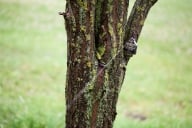You have /5 articles left.
Sign up for a free account or log in.
On our recent New Year’s trip to Friday Harbor, Washington, my eight-year old had the chance to reconnect with one of his buddies, a boy his age he’s known and played with since they were toddlers. A group of us went for a long walk in the woods, and the boys tagged along. The boys were shy together at first, but they soon adjusted to their own pace on the hike, falling behind to splash in puddles and pick up sticks. I lagged behind the other adults to keep an eye on the kids, and as I picked up bits of the boys’ conversation, I slowed down even more because I was so intrigued by their chatter. Instead of sharing stories about video games, TV shows or cool tricks they could do on their skateboards, they were talking about wild berries. My son pointed to some snowberries, prominent on the bushes during winter, and said he wished the snowberries would do their job and make it snow. His buddy pointed to some tangles of bare salmonberry bushes and said he couldn’t wait until salmonberry season because he loved to eat salmonberries. “Yeah, those are great!” my son said, adding that there are tons of them around our house. “And lots of red huckleberries too. We eat them all the time.”
Then the friendly boy banter began: “Oh, yeah? Well, at my grandpa’s house we have huckleberries and blackberries.”
“Well, by my house we can pick five different kinds of berries.”
“My grandpa took us on a walk in the woods and we found wild strawberries. And a dead fox.”
“Awesome! I went on a walk with my mom by our house, and I found a dead mole!”
“Cool! I found a deer skeleton.”
This went on and on, from winter berries, to edible berries, to animal carcasses. Then suddenly the boys realized they’d fallen behind and sprinted past me to catch up with the group. I was left alone to contemplate what I’d just overheard. Something’s right with the world when kids can appreciate nature and talk about it with one another, without interruption or prompting from adults.
It’s not that my husband and I have been particularly good about getting our kids out on hikes in the woods or on camping expeditions. Of course as biologists we’re always passing on stories about the natural world to our kids. But the other kids in our neighborhood have similar natural experiences. We’re lucky that we live near a small patch of open woods where the older neighborhood kids can go with their buddies to make forts and play spies, or where the grown-ups play hide-and-seek behind the trees with the little children. And we point out the different plants and animals or eat berries while we’re playing. Our excursions don’t have to be planned—they just happen whenever we want to, after supper in the summer when we need a walk or in the winter rain when we just need to get out of the house.
Unfortunately, this kind of situation is rare since most kids don’t have access to woods in their backyards, or if they do it’s not safe to play there. As Richard Louv writes in Last Child in the Woods, nature-deficit disorder is increasingly common. It was hard for me to believe that a number of my university students were intimidated by the idea of a class field trip to a wilderness site, even for an afternoon. I was a biology instructor on a team-taught course for first-year science students. As part of the curriculum, there were several field trips to some beautiful places, including a bog, a rocky coastline, and a wooded beach area. Many of the students complained about going on the trips, that this part of the curriculum had nothing to do with getting into med school or the pharmacy program. I wanted to say (like I sometimes want to say to my kids) “You’ll go and you’ll like it, damn it!” The majority of students ended up seeing these excursions as an opportunity to see something they’d never seen before. And a few students told us later that they’d had so much fun that they’d taken their friends back there on the weekend. Sure, these students went on to be doctors and pharmacists, but maybe the experiences we gave them in a natural habitat opened their eyes a bit to something new. After all, even sphagnum moss is ‘awesome’ when it’s surrounded by wild cranberries and huckleberries.





